We added 0.2cc of concentrated (1 gtt/ml) dye to the lowest port of the Baxter tubing.
Then we slowly dripped i.v. fluid through, and watched the color of the drops falling from the end of the i.v.
We compared the colors to short swatches of tubing containing known concentrations of dye (1 gtt/ml, 0.2 gtt/ml, 0.1, 0.05,0.02, 0.005, and 0.002 gtt/ml).
The chart shows the rise and fall in concentration of dye (“drug”) reaching the “patient” as the “med infusion” and “flush” ran.
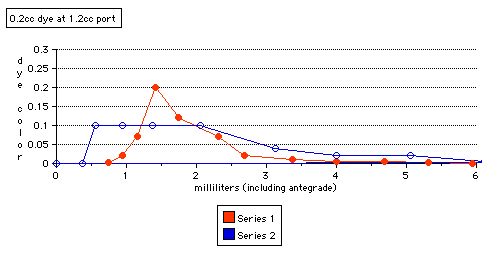
The first time (solid dots), the dye began to reach the “patient” after about 1 to 1.5cc were given, which is as expected for the 1.2cc (distal) port. The concentration rose rapidly to a peak of about 0.2 (drops/cc concentration), then tailed off to nearly clear at around 3cc total.
The second time we performed the injection, we saw the dye move a little way down the tubing away from the port before we even began to drip the i.v. fluid. This may have been because we used D10 as a carrier the second time, or may have been related to injection speed, tubing angle, or other unknown differences. The dye began reaching the end of the tubing after about 1/2cc the second time, was more diluted, (see the empty circles remaining below 0.2 gtt/ml), and tailed off to near clear around 3 to 4 cc total.
The total amount of dilution was estimated as follows:
We defined the “total dilution” as the amount of fluid/flush which contained 90% of the dye. (Since the dye “tails off” gradually, you can’t say when 100% of the dye is in.)
This was determined by simply printing out the graph, and carefully cutting out and weighing more and more of the area under the tail. This works because the total amount of dye is proportional to the area under the curve.
Measuring the “hump” of the curve directly would’nt work because the height of the curve is less accurate. (Our color samples included 0.2 and 1.0, but nothing in between.)
In the first trial, 90% of the dye was given between 0.9cc and 2.8cc, for a total dilution of 1.9cc. You can also see that the solid-dot curve is above the 0.1 level (a concentration of 10% of the syringe concentration) from about 1 to 2 cc.
In the second trial, 90% of the dye was given between 0.3cc and 4.7cc, for a total dilution of 4.4cc. The solid-dot curve is at the 0.1 level from about 0.5 to 2 cc.
The maximum concentration when the “drug” reached the “patient” was 0.2, or 1/5 of the syringe concentration.
Rougher estimates for the other ports (based on visual inspection of the graphs below),
are as follows:
1cc at 6.5cc port:
4.5cc to 11cc, 90% of “drug” in 6.5cc, above 10% concentration for 4cc
Maximum concentration is 0.2, or 1/5 of the syringe concentration.
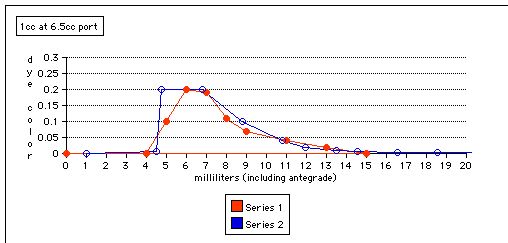
5cc at the 6.5cc (middle) port:
5cc to 14.5cc, or 90% of “drug” in 9.5cc, above 10% for about 9 or 15cc (Quite a range!)
The concentration rose to close to 1:1 (equal to the undiluted syringe concentration)
for 5cc of the infusion (5 to 10cc or 6 to 12cc).
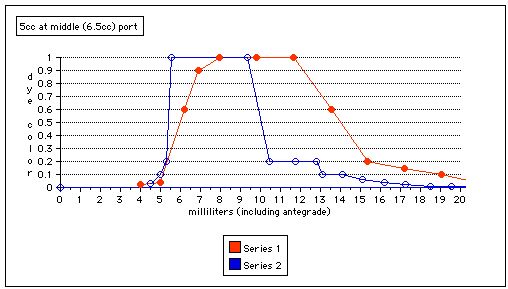
5cc at 12.5cc (upper) port:
10.5cc to 19.5cc, 90% of “drug” in 9cc, above 10% for about 10.5cc
The concentration rose to close to 1:1 (equal to the undiluted syringe concentration)
for 6cc of the infusion (12cc to 18 or 19cc).
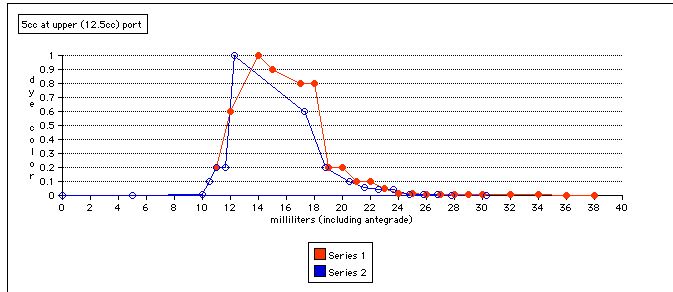
12cc at 12.5cc (upper) port:
10cc to 27.5cc, 90% of “drug” in 17.5cc, above 10% for 21cc
The concentration rose to close to 1:1 (equal to the undiluted syringe concentration)
for 15cc of the infusion (11cc to 26cc).
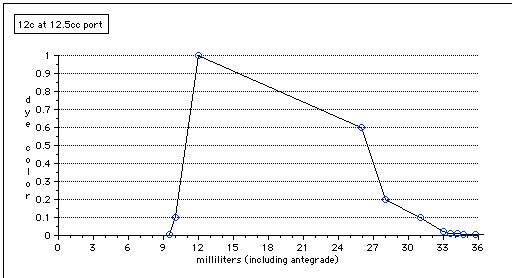
The above infusion: 12cc at the 12.5cc port, was checked only once (in the second series of checks, using D10% as the carrier).
The effect of viscous or oily medications or carriers was not checked, although you may note that the carrier was Plasmalyte (electrolytes only) in the first series and Dextrose 10% in the second. The effect of clearing the injection port versus leaving concentrated medication sequestered there was also not quantitatively checked.
